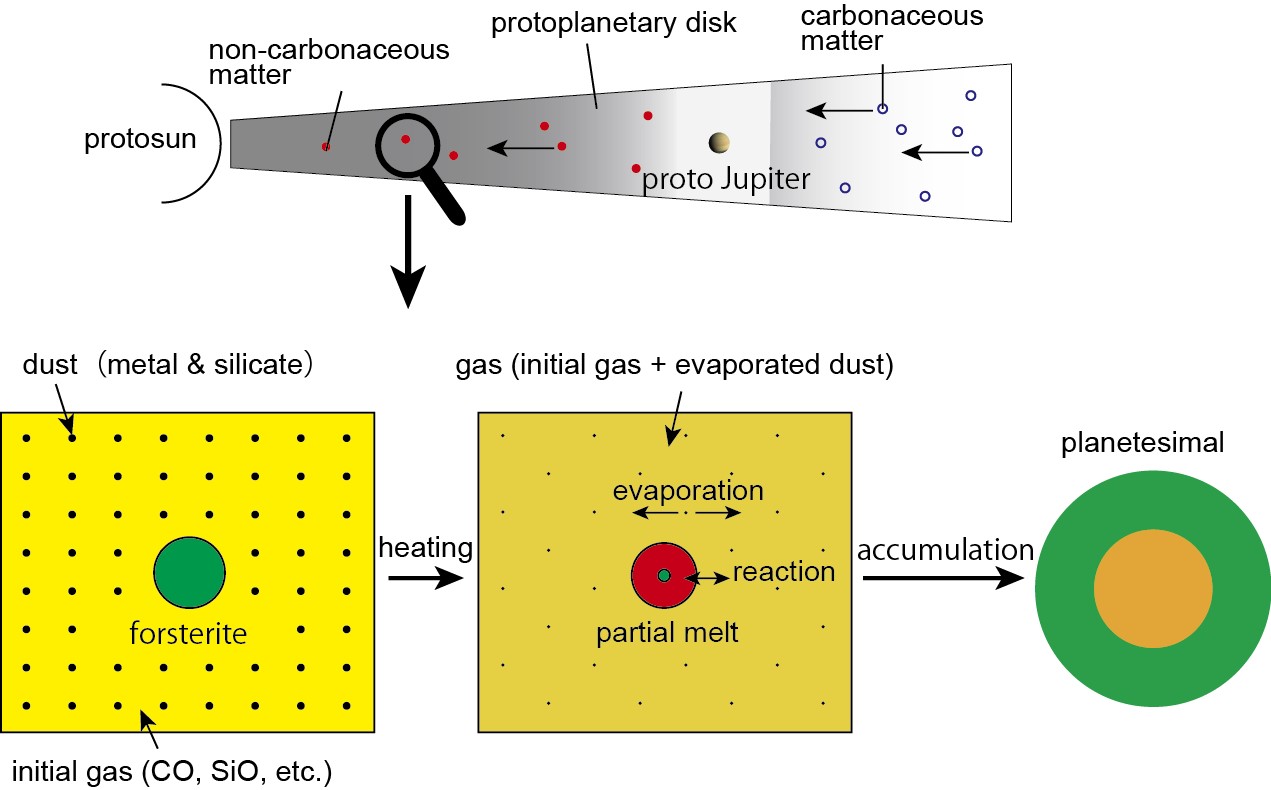Unravelling the chemical evolution of terrestrial planets in the early solar system: evidence from the isotopic composition of silicon and oxygen, which make up half of the Earth's mass
Terrestrial planets in our solar system formed in the protoplanetary disk about 4.6 billion years ago. As the disk cooled, planetesimals and planetary embryos formed, and they repeatedly collided and grew, eventually forming terrestrial planets. Since primitive meteorites contain primitive dust and fragments of planetesimals, analysis of these materials can provide direct information on the formation process of terrestrial planets.

Based on the results of isotopic analyses of meteorites, it has been suggested that terrestrial planets formed mainly from non-carbonaceous materials, which formed in the inner solar system (Fig. 1). In particular, enstatite chondrites, one of the non-carbonaceous primitive meteorites, have been considered to be the primary material from which the Earth and Moon were formed. This is because oxygen isotopic composition and nucleosynthetic isotopic anomalies of the enstatite chondrites are nearly identical with those of the Earth and Moon. On the other hand, it has also been proposed that terrestrial planets formed as a result of the mixing of various proportions of carbonaceous chondrite meteorite parent bodies with ureilite-like planetary materials, characterized by neutron-poor nucleosynthetic isotope anomalies among non-carbonaceous meteorites.
However, these models were contradicted by the fact that (1) the isotopic composition of silicon (δ30Si), a major component of the Earth, is higher than that of enstatite chondrites, ureilites and carbonaceous chondrites, and that (2) the isotopic composition of oxygen (Δ17O) in ureilites and carbonaceous chondrites is lower than that of the Earth. These models also could not explain why the Si/Mg of the Bulk Silicate Earth is lower than that of the chondritic value, even though most of the Earth's silicon is contained in the mantle and crust. Models to explain these reasons have included the evaporation of silicon during planetary collision or partitioning of significant amounts of silicon into the core during the core-mantle separation, leading to increase δ30Si value in the Earth's mantle and to decrease Si/Mg. However, none of these hypotheses is conclusive and new research was needed.
Terrestrial planets and asteroids are mainly made up of metals and silicates, about half of which are made up of silicon and oxygen. Therefore, elucidating the evolution processes of silicon and oxygen in the inner protoplanetary disk is an essential clue to the formation and chemical composition of terrestrial planets.
In order to solve this, we analyzed the oxygen and silicon isotopic compositions of chondrules separated from enstatite chondrites and of ureilite. The former represents the primitive components formed in the disk, which can be the major building blocks of the Earth, and the latter represents end components of non-carbonaceous planetary materials formed about 0.1 million years after the formation of the solar system.

Our result demonstrated that although ureilite has a wide range of oxygen isotopic compositions, their silicon isotopic compositions are homogeneous. This result indicates that about 0.1 million years after the formation of the solar system, oxygen isotope heterogeneity existed in the inner part of the primitive solar system disk, but silicon isotope homogenization had already been achieved. In contrast, chondrules in enstatite chondrites show a wide range of silicon isotopic compositions consistent with those of the Earth, Moon, Mars and non-carbonaceous asteroidal meteorites (Fig. 2).
The relationship between silicon and oxygen isotopes of these inner planetary materials is explained by an interaction between the evaporation-driven SiO-rich gas and partially or fully melted forsterite-rich precursor chondrules (Fig. 1). The environment in which the EC chondrules formed had regions with relatively high and low dust/gas, silicate/metal in the dust, and Mg/Si in the dust-gas mixtures, which may have determined the variations in EC chondrules, with lower Δ17O and higher δ30Si and with higher Δ17O and lower δ30Si, respectively. (Fig. 2).
Based on our data and previous studies, we proposed that the evolution of the δ30Si value of the inner solar system could have proceeded as follows: (1) The δ30Si value of SiO in the solar nebula was initially low at ~−7‰ when the amoeboid olivine aggregates (Δ17O ~25‰ to −20‰) and Fe-rich metal condensed. (2) Subsequently, the δ30Si values became higher, mainly due to metal condensation, and reached ~2.5‰ by the time when the olivine-rich chondrule (Δ17O ~6‰ to −1‰) and precursors of the ureilite parent body (Δ17O −2‰ to 0‰) were formed. (3) Then, evaporation-driven melt-gas interactions between the forsterite-rich chondrule melts and the SiO-rich nebular gas that evolved by dust evaporation led to variations in the δ30Si (−0.5‰ to −0.2‰) and Δ17O (−0.5‰ to +0.8‰) values for enstatite-rich chondrules.
The magnesium/silicon ratio and the oxygen and silicon isotopic composition of the dust and gas mixture depended on the dust/gas ratio in the disk and the metal/silicate ratio in the dust. Our results indicate that the chemical composition of terrestrial planets was controlled by the dust and gas composition of the source regions in the disk. The composition of chondritic meteorites does not necessarily directly reflect the chemical composition of the terrestrial planets.
References:
- Ryoji Tanaka, Christian Potiszil, Eizo Nakamura. Silicon and Oxygen Isotope Evolution of the Inner Solar System, The Planetary Science Journal, 2, 102 (2021). doi:10.3847/PSJ/abf490, dream/20210523235711-005837.